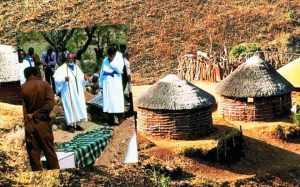When you search for the word Agadez (Niger) on Google Maps, a remote point in a vast expanse of white land appears on the map of Africa. That remote point is Agadez, the gateway to the desert, the place of departure and arrival of the great Sahara Desert, the city where the commercial caravans used to prepare the supplies necessary to cross it.
Salt, gold, slaves and ivory were the most sought-after products from West Africa: once they reached the shores of the Mediterranean, they were sold and exchanged for manufactured goods and cereals that returned south of the Sahara. In that remote point on the map of Africa, the city of Agadez, hundreds of sub-Saharan migrants live today, some with dreams broken forever and others with dreams, yet to be realized, of a better and different life.
Sociologist Sumana Adamu defines Agadez as “an important commercial crossroads for caravaners, a hub between black Africa and the Maghreb, where hospitality is an essential value for the local population”. The name comes from the word ‘egdez‘, which in Tamasheq, the language of the Tuareg community that founded the city, means ‘to pay a visit’. This explains the explosion of ethnic diversity in this city, where ethnic groups such as Hausa, Arab, Kanuri, Songhai and Peul live in perfect symbiosis. Agadez has historically been the main gateway to the Sahara, the city of caravans to Libya and North Africa and, if possible, to Europe. A few years ago, before the crisis that the city is experiencing today, every Monday dozens of vehicles left for the desert to transport goods, livestock and passengers, mainly coming from West Africa, in the hope of reaching Libya and, “In cha’ Allah” (God willing), Europe. Furthermore, in the 1980s, Agadez was at the centre of exotic tourism with daily charter flights, provoked by the Paris-Dakar Rally, with an important stop in this Nigerian city. A local says: “Agadez received thousands of tourists who came from Europe and America to discover the Ténéré desert, the Bilma dunes and the Air mountains.”
But the arrival of Islamic Jihadism in the Sahel countries has completely changed the situation in Agadez and, in the words of an old local craftsman, “no one comes to visit us or buy our products anymore”. But Agadez has a past and a history that we want to remember in the hope of better times for its population. Agadez is an urban municipality in Niger, located in the centre of the country. In 2012 it had a population of 118,240. (Last census)
In 2013, UNESCO declared the historic centre, built with mud bricks during the Tuareg Sultanate of Air, a World Heritage Site. In total, the city is divided into eleven neighbourhoods spread over 70 hectares. Highlights include the Great Mosque and its sky-defying earthen minaret (the most iconic minaret in the Sahel, which inspired a new architectural genre called “Sudanese”), the Sultan’s Palace, the House of Sidi Kâ, also called the Baker’s House, and the home of the erudite German explorer and linguist Henri Barth (1821-1865), who settled in the city in 1850.
The Great Mosque is the visiting card of Agadez, being undoubtedly one of the most representative monuments of the “Sudanese” style in Africa, with its 27-meter-high minaret. Starting with the construction of stepped bastions with crossed wooden beams visible from the outside, countless mosques and secular buildings followed this pattern and developed it in their own way. Notable examples are the mosques of Timbuktu (Mali), Djenné (Mali), Bobo Dioulasso (Burkina Faso) and Larabanga (Ghana).
Visiting and walking around the city is an experience that is difficult to forget. A journalist describes it like this: “Walking through Agadez is an extraordinary experience; the blinding white light of the desert and the omnipresent dust contrast with the traditional rammed earth architecture that characterizes this strip of the Sahel. The streets and buildings of reddish colour recall a historical period that has stopped and is in danger of extinction. Due to the aridity of the environment, the wind and the lack of rainfall in the region, the walls of the buildings are often rebuilt periodically.”
The history of Agadez is very ancient: according to tradition, it was founded in the 11th century by the Sanhaya or Zenegi and in the 14th century it became the most important city of the Tuareg, growing thanks to transport and trans-Saharan trade. Its economy was based on Bilma salt, brought by caravans.
Books tell us that in 1500 Agadez had a population of around 30,000 people and was already the main passage for medieval caravans trading between the African cities of Kano in Nigeria and Timbuktu in Mali, the oases of the north and the Mediterranean coast. From a cultural point of view, mention should be made of the artisans of the past and present, renowned throughout the Sahel for their skill and mastery in the working of leather, silver and other metals.
The beautiful cross of Agadez is an example of this. There is also their musical richness. “Based on oral tradition, the Agadez scene focuses particularly on dance, poetry, oral storytelling and music. These three ancestral traditions have rich typologies that vary in each of the areas of the Agadez region, in many cases isolated between them and separated by kilometres of dust and sand” (Afribuku. Contemporary African Culture, 2019). Agadez today lives in a vital lethargy due to the instability caused by the Nigerian Tuareg uprisings (2007-2009), the war in northern Mali, the powder keg of Boko Haram violence in northern Nigeria and the arrival of Jihadism in the Sahel. But it remains a unique city, where the weight of centuries can be felt in every street and where you can smell the aroma of history. (Juan José Osés / Africana) – (Photo: File swm)







